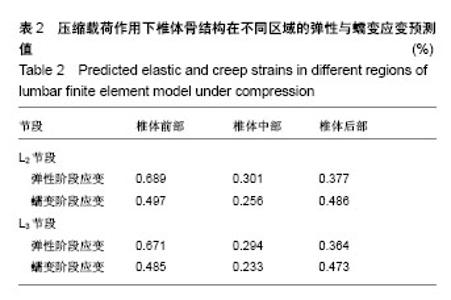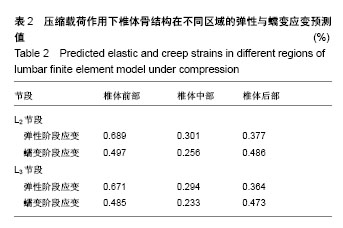Chinese Journal of Tissue Engineering Research ›› 2018, Vol. 22 ›› Issue (35): 5648-5654.doi: 10.3969/j.issn.2095-4344.1011
Previous Articles Next Articles
Mechanism of the low-frequency vibration generated by vehicle driving effects on the human lumbar spine: a dynamic simulation analysis
Fan Ruoxun1, 2, Liu Jie1, Liu Jun3, Gao Jiazi2
- 1College of Automotive Engineering, Jilin Institute of Chemical Technology, Jilin 132022, Jilin Province, China; 2College of Mechanical Science and Engineering, Jilin University, Changchun 130025, Jilin Province, China; 3the Second Hospital of Jilin University, Changchun 130025, Jilin Province, China
-
Online:2018-12-18Published:2018-12-18 -
About author:Fan Ruoxun, PhD, Lecturer, College of Automotive Engineering, Jilin Institute of Chemical Technology, Jilin 132022, Jilin Province, China; College of Mechanical Science and Engineering, Jilin University, Changchun 130025, Jilin Province, China -
Supported by:the Science and Technology Project of the Education Department of Jilin Province, No. JJKH20180560KJ; the Open Foundation of the State Key Laboratory of Automotive Simulation and Control, No. 20171114
CLC Number:
Cite this article
Fan Ruoxun, Liu Jie, Liu Jun, Gao Jiazi. Mechanism of the low-frequency vibration generated by vehicle driving effects on the human lumbar spine: a dynamic simulation analysis [J]. Chinese Journal of Tissue Engineering Research, 2018, 22(35): 5648-5654.
share this article
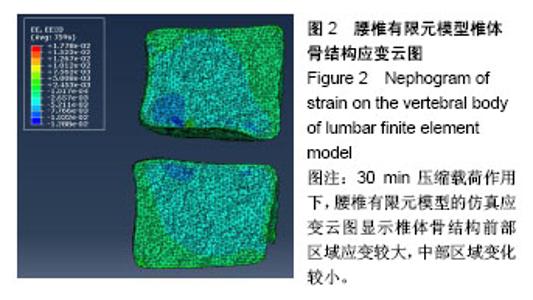
2.1 腰椎有限元模型验证 为验证所建立腰椎有限元模型的准确性,需与文献中腰椎压缩实验数据进行对比。通过模拟实验加载条件,对腰椎有限元模型施加30 min、 1 000 N的轴向压力,预测椎体骨结构产生的应变值[31]。文献中腰椎压缩实验测得椎体前、中、后部区域在弹性阶段的应变分别为0.694%,0.301%和0.388%,在蠕变阶段的应变分别为0.433%,0.163%和0.614%,说明椎体前部变形最大,中部最小。如图2所示,腰椎有限元模型的仿真应变云图也同样显示椎体骨结构前部区域应变较大,中部较小,而且如表2所示,在30 min压缩载荷作用下,该文所建立模型预测得出椎体骨结构在各个位置的应变值也与实验值较为接近,验证了所建立腰椎有限元模型的准确性。"
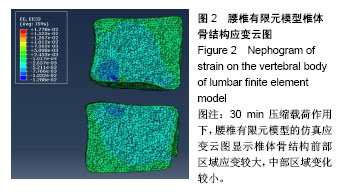
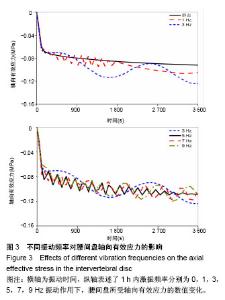
2.2 不同振动频率对腰间盘轴向有效应力的影响 轴向有效应力是指由多孔结构中固体骨架所承载的外部轴向(Z轴)压力。图3显示了不同振动频率作用下腰间盘所受平均轴向有效应力随加载时间的变化情况(平均轴向有效应力指腰间盘所有单元产生的轴向有效应力总和除以腰间盘单元总数)。 首先可以看出,不同频率振动下轴向有效应力均随加载时间逐渐增大,但增幅不同。相比动态载荷,静态载荷产生的应力明显偏小,且随时间增长幅度也较小;1 Hz振动产生的轴向有效应力在加载前期数值变化频率较快,在后半段逐渐呈线性稳定趋势;3 Hz振动产生的轴向有效应力在加载后半程明显大于其他振动频率,且与其他振动频率产生的应力差值随时间增长有扩大趋势;7 Hz与9 Hz的振动规律较为相似,轴向有效应力的最大值与最小值在后半段均大于5 Hz,并且二者产生的应力值在后半段的数值变化也基本呈现稳定的周期变换状态。"
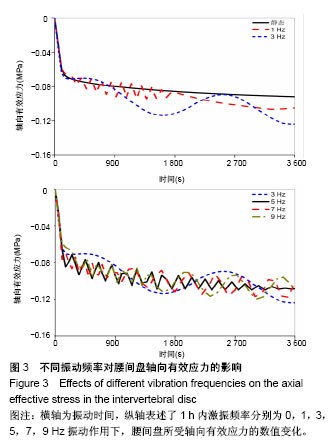
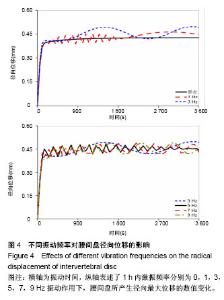
2.3 不同振动频率对腰间盘径向位移的影响 图4显示了不同振动频率作用下腰间盘径向最大位移随振动时间的变化情况。 在加载起始阶段,各位移曲线均呈线性上升状态,短时间内达到较高值,随后上升趋势变缓。在加载前半段,不同频率振动所致径向位移曲线均呈周期循环变化,而且位移峰值相差较小。在加载后半段,1 Hz振动作用下径向最大位移未继续呈周期循环变化;5 Hz振动作用下,径向位移虽仍呈周期循环变化,但曲线波峰波谷数值差异逐渐缩小,有趋于稳定的趋势;相反,3 Hz振动产生的曲线变化周期长,数值变换幅度大,且位移峰值明显大于其他振动频率所产生的位移;7 Hz与9 Hz振动在加载初期数值的变化周期较小,随着加载时间增长,位移曲线逐渐呈现一种稳定状态,即在加载后期,不同周期下位移的最大值与最小值基本保持不变。"
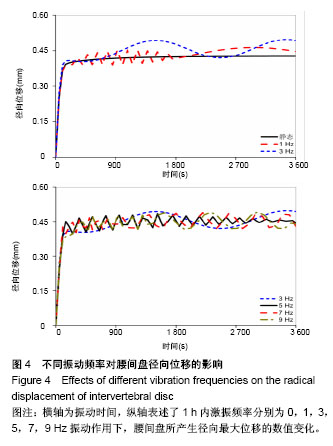
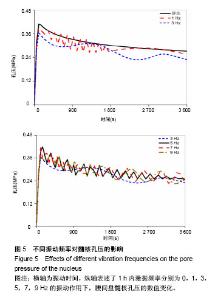
2.4 不同振动频率对髓核孔压的影响 孔压指在多孔结构中由于体液交换引起压差所产生的一种能够抵抗外部压力的压强。孔压与有效应力共同组成了多孔结构在外部载荷作用下所承载的应力总和。图5显示了髓核平均孔压在不同振动频率作用下的变化(髓核平均孔压指髓核所有单元产生的孔压总和除以髓核单元总数)。首先可以看出不同载荷作用下,孔压在加载起始阶段达到峰值,而后随加载时间增长逐渐消散。静态载荷作用下孔压峰值最大,且下降幅度最小,加载结束时孔压值最高;1 Hz振动作用下髓核孔压数值在前期变化频率较快,后期呈稳定趋势;3 Hz振动的孔压曲线与其他振动有显著差异,虽也呈现周期变化,但每个周期内孔压数值变化大,且随周期变化孔压下降幅度也较大,与其他频率作用下的孔压差值有逐渐扩大的趋势;7 Hz与9 Hz振动所致的孔压变化情况基本相同,二者在初期引起的孔压最高值与孔压下降程度也基本一致,同时二者的孔压最小值均 < 5 Hz振动所产生的孔压值。"
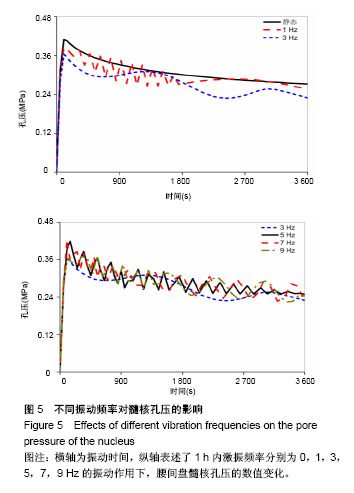
| [1] Kulduk A, Altun NS, Senkoylu A. Biomechanical comparison of effects of the dynesys and coflex dynamic stabilization systems on range of motion and loading characteristics in the lumbar spine: a finite element study. Int J Med Robot Comp. 2015;11(4):400-405. [2] 项嫔,都承斐,莫中军,等.不同振动载荷刺激对L1-L5腰椎的生物力学响应研究[J].生物医学工程学杂志,2015,32(1):48-54.[3] Fan W, Guo LX. Finite element investigation of the effect of nucleus removal on vibration characteristics of the lumbar spine under a compressive follower preload. J Mech Behav Biomed. 2018;78:342-351. [4] Stokes IA, Gardner-Morse M. A database of lumbar spinal mechanical behavior for validation of spinal analytical models. J Biomech. 2016;49(5):780-785. [5] 于红,吴闻文,侯树勋,等.汽车驾驶员腰椎保护带的振动防护效应测试及其生物力学作用分析[J].生物医学工程学杂志, 2000, 17(3):270-272.[6] Fan RX, Gong H, Qiu S, et al. Effects of resting modes on human lumbar spines with different levels of degenerated intervertebral discs: a finite element investigation. BMC Musculoskel Dis. 2015;16:221. [7] Galbusera F, Schmidt H, Wilke CN, et al. The mechanical response of the lumbar spine to different combinations of disc degenerative changes investigated using randomized poroelastic finite element models. Eur Spine J. 2011;20(4): 563-571. [8] 徐浩,张秋林,唐昊,等.腰椎L3-L5三维有限元模型的有效性验证[J].中国组织工程研究,2013,17(35):6261-6266.[9] Schmidt H, Shirazi-Adl A, Galbusera F, et al. Response analysis of the lumbar spine during regular daily activities-a finite element analysis. J Biomech. 2010;43(10):1849-1856. [10] Schmidt H, Galbusera F, Rohlmann A, et al. What have we learned from finite element model studies of lumbar intervertebral discs in the past four decades? J Biomech. 2013;46(14):2342-2355. [11] 李杰,王洪岗,尚进,等.经椎间孔腰椎椎间融合术植骨融合前后应力分布差异的有限元分析[J].第三军医大学学报, 2015,37(14): 1449-1454.[12] Goel VK, Park H, Kong WZ. Investigation of vibration characteristics of the ligamentous lumbar spine using the finite element approach. J Biomech Eng. 1994;116(4): 377-383. [13] 李睿,郭立新.非持续载荷下腰间盘的多孔弹性特性[J].东北大学学报,2013,34(4):573-577.[14] Massey CJ, Van Donkelaar CC, Vresilovic E, et al. Effects of aging and degeneration on the human intervertebral disc during the diurnal cycle: a finite element study. J Orthop Res. 2012;30(1):122-128. [15] Fan W, Guo LX. Influence of different frequencies of axial cyclic loading on time-domain vibration response of the lumbar spine: a finite element study. Comput Biol Med. 2017; 86(1):75-81. [16] Newell N, Little JP, Christou A, et al. Biomechanics of the human intervertebral disc: a review of testing techniques and results. J Mech Behav Biomed. 2017;69:420-434. [17] Schmidt H, Kettler A, Heuer F, et al. Intradiscal pressure, shear strain, and fiber strain in the intervertebral disc under combined loading. Spine. 2007;32(7):748-755. [18] Argoubi M, Adl AS. Poroelastic creep response analysis of a lumbar motion segment in compression. J Biomech. 1996; 29(10):1331-1339. [19] Xu X, Tang H, Guan XM, et al. Biomechanical comparison of posterior lumbar interbody fusion and transforaminal lumbar interbody fusion by finite element analysis. Neurosurgery. 2013;72:21-26. [20] Schmidt H, Bashkuev M, Galbusera F, et al. Finite element study of human lumbar disc nucleus replacements. Comp Methods Biomech Biomed Eng. 2014;17(16):1762-1776. [21] Schmidt H, Bashkuev M, Dreischarf M, et al. Computational biomechanics of a lumbar motion segment in pure and combined shear loads. J Biomech. 2013;46(14):2513-2521. [22] Sharma M, Langrana NA, Rodriguez J. Role of ligaments and facets in lumbar spinal stability. Spine. 1995;20(8):887-900. [23] Cheung JTM, Zhang M, Chow DHK. Biomechanical responses of the intervertebral joints to static and vibrational loading: a finite element study. Clin Biomech. 2003;18(9): 790-799. [24] 李睿,郭立新.低频振动作用下人体腰间盘多孔弹性单元的研究[J].应用力学学报,2013,30(4):635-640.[25] Qiu Y, Griffin MJ. Transmission of vibration to the backrest of a car seat evaluated with multi-input models. J Sound Vib. 2004;274(1-2):297-321. [26] Li Y, Lewis G. Influence of loading cycle profile and frequency on a biomechanical parameter of a model of a balloon kyphoplasty-augmented lumbar spine segment: a finite element analysis study. Bio-Med Mater Eng. 2010;20(6): 349-359. [27] Verver MM, Hoof JV, Oomens CWJ, et al. Estimation of spinal loading in vertical vibrations by numerical simulation. Clin Biomech. 2003;18(9):800-811. [28] Han KS, Rohlmann A, Yang SJ, et al. Spinal muscles can create compressive follower loads in the lumbar spine in a neutral standing posture. Med Eng Phys. 2011;33(4):472-478. [29] Fan W, Guo LX. Dynamic response of the lumbar spine to whole-body vibration under a compressive follower preload. Spine. 2018;43(3):143-153. [30] Hill TE, Desmoulin GT, Hunter CJ. Is vibration truly an injurious stimulus in the human spine? J Bio. 2009;42(16): 2631-2635. [31] Pollintine P, Luo J, Offa-Jones B, et al. Bone creep can cause progressive vertebral deformity. Bone. 2009;45(3):466-472. [32] 国云鹏,宋桂秋.基于高速铁路随机振动环境对人体腰椎影响的人机工程座椅设计[J].中国机械工程,2015,26(3):389-393.[33] Yoganandan N, Umale S, Stemper B, et al. Fatigue responses of the human cervical spine intervertebral discs. J Mech Behav Biomed. 2017;69:30-38. [34] Dong RC, Guo LX. Effect of muscle soft tissue on biomechanics of lumbar spine under whole body vibration. Int J Precis Eng Man. 2017;18(11):1599-1608. [35] Guo LX, Fan W. The Effect of single-level disc degeneration on dynamic response of the whole lumbar spine to vertical vibration. World Neurosurg. 2017;105:510-518. [36] Kumar S. Vibration in operating heavy haul trucks in overburden mining. Appl Ergon. 2004;35(6):509-520. [37] Adams MA, Dolan P. Intervertebral disc degeneration: evidence for two distinct phenotypes. J Anat. 2012;221: 497-506. [38] Etienne M, Deplano V, Boiron O, et al. 3D dynamic numerical simulations of intervertebral disc: bending and twisting. Comput Method Bio Mec. 2014;16(S1):236-238. [39] Wagnac E, Arnoux PJ, Garo A, et al. Calibration of hyperelastic material properties of the human lumbar intervertebral disc under fast dynamic compressive loads. J Biomech Eng. 2011;133(10):101007. [40] Zheng JJ, Tang L, Hu JW. A numerical investigation of risk factors affecting lumbar spine injuries using a detailed lumbar model. Appl Bionics Biomech. 2018:8626102. |
| [1] | Zhang Tongtong, Wang Zhonghua, Wen Jie, Song Yuxin, Liu Lin. Application of three-dimensional printing model in surgical resection and reconstruction of cervical tumor [J]. Chinese Journal of Tissue Engineering Research, 2021, 25(9): 1335-1339. |
| [2] | Chen Xinmin, Li Wenbiao, Xiong Kaikai, Xiong Xiaoyan, Zheng Liqin, Li Musheng, Zheng Yongze, Lin Ziling. Type A3.3 femoral intertrochanteric fracture with augmented proximal femoral nail anti-rotation in the elderly: finite element analysis of the optimal amount of bone cement [J]. Chinese Journal of Tissue Engineering Research, 2021, 25(9): 1404-1409. |
| [3] | Zeng Yanhua, Hao Yanlei. In vitro culture and purification of Schwann cells: a systematic review [J]. Chinese Journal of Tissue Engineering Research, 2021, 25(7): 1135-1141. |
| [4] | Cai Qunbin, Zou Xia, Hu Jiantao, Chen Xinmin, Zheng Liqin, Huang Peizhen, Lin Ziling, Jiang Ziwei. Relationship between tip-apex distance and stability of intertrochanteric femoral fractures with proximal femoral anti-rotation nail: a finite element analysis [J]. Chinese Journal of Tissue Engineering Research, 2021, 25(6): 831-836. |
| [5] | Song Chengjie, Chang Hengrui, Shi Mingxin, Meng Xianzhong. Research progress in biomechanical stability of lateral lumbar interbody fusion [J]. Chinese Journal of Tissue Engineering Research, 2021, 25(6): 923-928. |
| [6] | Liu Zhao, Xu Xilin, Shen Yiwei, Zhang Xiaofeng, Lü Hang, Zhao Jun, Wang Zhengchun, Liu Xuzhuo, Wang Haitao. Guiding role and prospect of staging and classification combined collapse prediction method for osteonecrosis of femoral head [J]. Chinese Journal of Tissue Engineering Research, 2021, 25(6): 929-934. |
| [7] | Xu Dongzi, Zhang Ting, Ouyang Zhaolian. The global competitive situation of cardiac tissue engineering based on patent analysis [J]. Chinese Journal of Tissue Engineering Research, 2021, 25(5): 807-812. |
| [8] | Wu Zijian, Hu Zhaoduan, Xie Youqiong, Wang Feng, Li Jia, Li Bocun, Cai Guowei, Peng Rui. Three-dimensional printing technology and bone tissue engineering research: literature metrology and visual analysis of research hotspots [J]. Chinese Journal of Tissue Engineering Research, 2021, 25(4): 564-569. |
| [9] | Chang Wenliao, Zhao Jie, Sun Xiaoliang, Wang Kun, Wu Guofeng, Zhou Jian, Li Shuxiang, Sun Han. Material selection, theoretical design and biomimetic function of artificial periosteum [J]. Chinese Journal of Tissue Engineering Research, 2021, 25(4): 600-606. |
| [10] | Liu Fei, Cui Yutao, Liu He. Advantages and problems of local antibiotic delivery system in the treatment of osteomyelitis [J]. Chinese Journal of Tissue Engineering Research, 2021, 25(4): 614-620. |
| [11] | Li Xiaozhuang, Duan Hao, Wang Weizhou, Tang Zhihong, Wang Yanghao, He Fei. Application of bone tissue engineering materials in the treatment of bone defect diseases in vivo [J]. Chinese Journal of Tissue Engineering Research, 2021, 25(4): 626-631. |
| [12] | Zhang Zhenkun, Li Zhe, Li Ya, Wang Yingying, Wang Yaping, Zhou Xinkui, Ma Shanshan, Guan Fangxia. Application of alginate based hydrogels/dressings in wound healing: sustained, dynamic and sequential release [J]. Chinese Journal of Tissue Engineering Research, 2021, 25(4): 638-643. |
| [13] | Chen Jiana, Qiu Yanling, Nie Minhai, Liu Xuqian. Tissue engineering scaffolds in repairing oral and maxillofacial soft tissue defects [J]. Chinese Journal of Tissue Engineering Research, 2021, 25(4): 644-650. |
| [14] | Chen Lu, Zhang Jianguang, Deng Changgong, Yan Caiping, Zhang Wei, Zhang Yuan. Finite element analysis of locking screw assisted acetabular cup fixation [J]. Chinese Journal of Tissue Engineering Research, 2021, 25(3): 356-361. |
| [15] | Xing Hao, Zhang Yonghong, Wang Dong. Advantages and disadvantages of repairing large-segment bone defect [J]. Chinese Journal of Tissue Engineering Research, 2021, 25(3): 426-430. |
| Viewed | ||||||
|
Full text |
|
|||||
|
Abstract |
|
|||||
